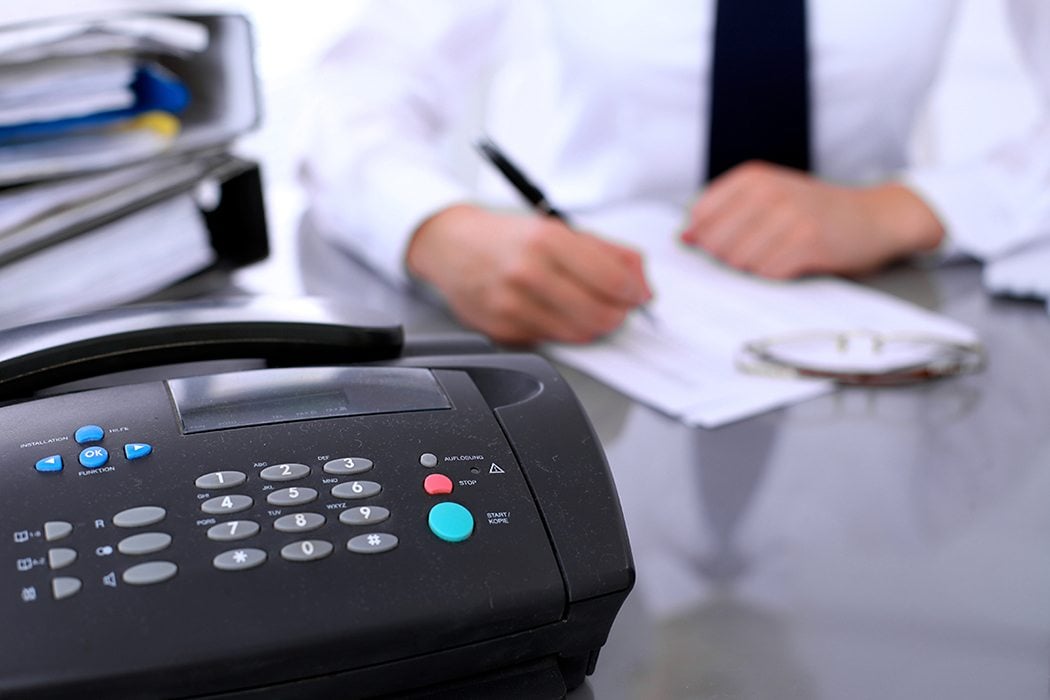{{item.title}}

Key takeaways
While the rest of modern society clamours to run big-data analyses on their jogging metrics stored on the cloud, one industry remains stuck in the past, and that’s healthcare.
With more paper flying around than a ticker-tape parade – prescriptions, hand-written notes, lab results, and so on – you’d be forgiven for wondering why digital rigour isn’t yet the norm in such a high-stakes, life or death environment.
At the centre of it all is the dinosaur in the room: the fax machine, which remains deeply ingrained as the dominant technology used to transmit critical and sensitive health information between doctor’s offices, clinics, labs and pharmacies.
The fax machine conferred such an impressive boost to productivity in the pre-internet 1980s, that one suspects its uncanny longevity is the result of a slightly bizarre nostalgia. Plus, to many there’s nothing inherently wrong with sending documents via fax. That is, of course, until us error-prone humans are added to the mix.
It’s not impossible for one’s entire medical history to fall into the wrong hands simply on account of a misdialled number. Accidents aside, the need for administration staff to have access usually forbids keeping it in a secure location, leaving an ever-mounting pile of documents in the receiving tray vulnerable to theft, loss or simply being overlooked.
Health information is much more useful when stored electronically, in a useable format, so that it can be indexed, searched and retrieved quickly.
A fax’s optical format – essentially, a picture of the data, not the data itself – isn’t immediately usable or actionable. A human must translate what’s on the page onto a suitable system before anything useful can be accomplished. In some clinics, this has necessitated the hiring of extra employees just for this purpose.
What the healthcare industry desperately needs is a secure and reliable means of recording, categorising and transmitting sensitive data between patients, clinics and pharmacies.
That doesn’t sound particularly challenging in 2017 and, indeed, such means do already exist – there are currently three major providers of secure messaging systems in Australia. However, due to differing data transmission protocols, only healthcare organisations using the same system have been able to exchange messages securely.
This presents a major barrier to adoption in an already highly conservative industry. To solve, an industry-wide set of specifications must be established that will allow software vendors and secure messaging service providers to develop systems that interoperate reliably (and universally).
In Australia, this effort is already under way. Known as Secure Message Delivery (SMD), it’s a standardised approach to digital health communication based on IT industry best practice specifications.
Progress toward setting this standard in stone has been consistent, but slow (as might be expected, considering it will require consensus among a large and diverse industry).
National body the Australian Digital Health Agency (ADHA) has been working to expedite the process, however, promoting it to the highest level of priority in the hope that it’ll be completed within the next 12 to 18 months.
If successful, the benefits should be wide ranging. Security-wise, patient records will be available only to the treating physician and kept from prying eyes.
With paper no longer necessary, time wasted on chasing clinical information, resending referrals – and simply all the cumbersome scanning, printing and filing – will be able to be allocated in more valuable ways.
Waiting times should decrease and quality of care should improve with the certainty that communications have been accurately received.
Ultimately, the digitisation of clinical data will create a foundation for the development of new, smarter software that consolidates patient data into a single searchable repository, with benefits to efficiency and continuity of care.
With the ADHA’s heightened commitment to arrive at a secure messaging standard, hopes are riding high that, in the not-too-distant future, the sole remaining use for this cumbersome, inaccurate and archaic technology will be as fuel for a raucous celebratory bonfire.
Get the latest in your inbox weekly. Sign up for the Digital Pulse newsletter.
Sign Up
References

© 2017 - 2025 PwC. All rights reserved. PwC refers to the PwC network and/or one or more of its member firms, each of which is a separate legal entity. Please see www.pwc.com/structure for further details. Liability limited by a scheme approved under Professional Standards Legislation.
